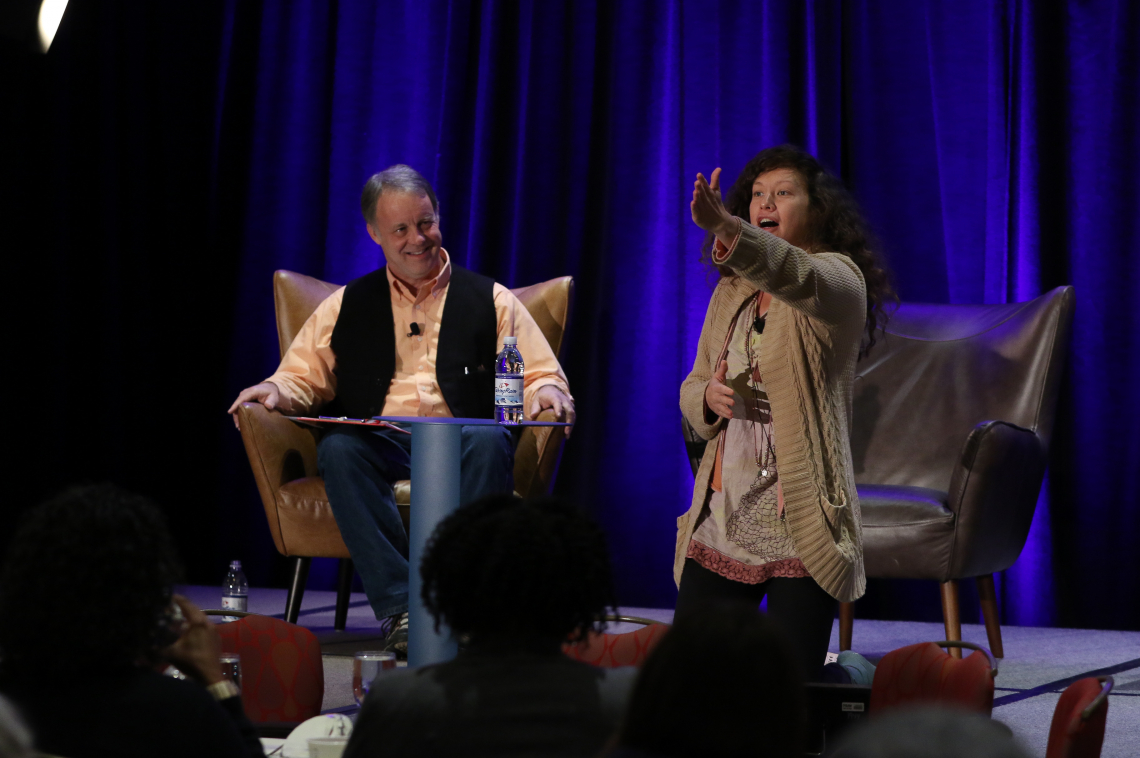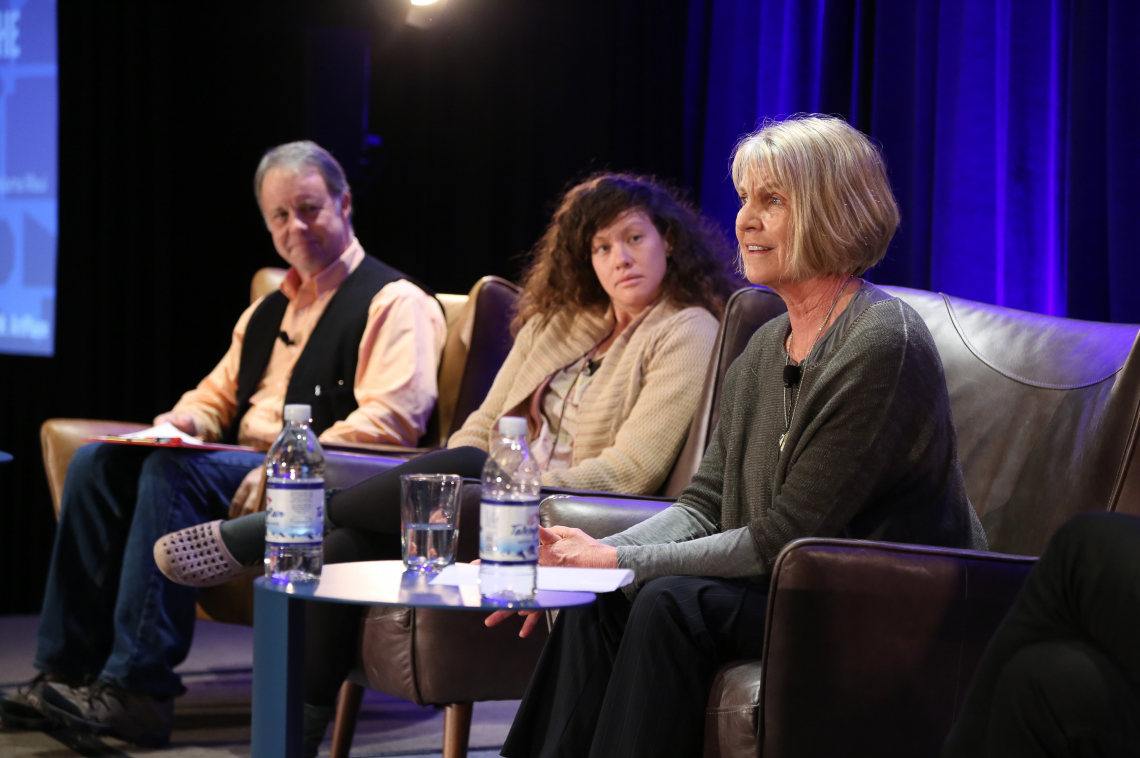

One of the most pressing (and polarizing) issues of our time is climate change. But figuring out how to tackle a problem that many feel detached from is another issue altogether. At this year’s ArtPlace Summit, we took some time to talk about how arts and culture can be used as tools to render the unseen visible and the abstract concrete. We wanted to know: How do we wrap up our vision for the sustainable transformation of the environment into an engaging and accessible package?
Our plenary was titled “Sight Unseen: Bringing the Environment to Life.” Speakers were Dede Taylor, producer and founding partner of Mountain Time Arts in Bozeman, Montana; Lehua Simon, cultural regeneration coordinator of Mālamalama Maui in Puʻunene, Hawaii; and Burt Lauderdale, executive director of Kentuckians for the Commonwealth in London, Kentucky. The plenary was moderated by Brady Walkinshaw, CEO of Grist.org.
In his introduction to the panel, Jamie Bennett, executive director of ArtPlace America, summarized the goal of the conversation.
“One of the things the environmental sector struggles with is, how do you help someone solve a problem they don’t know they have? So much of the environment can be invisible to us, so we want to investigate how artists and culture-bearers can help make visible some of the things we need to do today to make sure that our children have a tomorrow.”
Before you can solve a problem, you have to name it.
Though our panelists work in very different communities across the country, they all named the same environmental issues: drought, climate change, and water scarcity. For all three panelists, these challenges are compounded by additional struggles like population growth, economic instability and the growing pains that come with agricultural and economic transition.
For the people of Maui, a looming agricultural transition means seismic change and cultural anxiety. For over 140 years, sugar has dominated Hawaii’s economy and companies like Alexander & Baldwin (A&B) have been responsible for providing thousands of jobs while simultaneously engaging in environmental practices which some organizers–including panelist Lehua Simon–condemn as inequitable and unsustainable. Now, Hawaii’s sugar mills are closing.
“For the last century, A&B has been taking water from one side of the island–180 million gallons of water. And they’re putting less than half of that into the land and the communities,” Lehua explained. “The environmental impact of that is huge. Without having water that goes from the mountain to the stream, we lose native plant life, native animal life and food sources that Hawaiians have depended on for years.”
Through Mālamalama Maui, Lehua works to create media that addresses a “collective vision” for the 36,000 acres of sugar plantations in the center of Maui which will soon be repurposed. Mālamalama Maui uses a system of “expanding circles of influence” to build that 10-year transition vision. By holding events like the Memorial Day weekend #Walk4Water–a walk guided by local women which follows the natural path of water from the mountains to the sea–the organization ultimately hopes to engage over 10,000 citizens in its fight for unfettered access to local water.
In Kentucky, residents are facing similar challenges.
“Coal has been really dominant politically and socially as an economic force in Kentucky for over a century,” Burt Lauderdale said. “We’ve been advocating for a just transition in the region and the country to get beyond fossil fuels and to a sustainable economy and a survivable set of energy resources. The old coal economy is in free-fall in Appalachia. It’s unclear right now what’s going to take its place.”
But the situation in Kentucky is proof positive that harnessing culture as a tool for change can become problematic. As Kentuckians for the Commonwealth worked with the community to design the “Empower Kentucky Plan,” an equitable transition plan which aimed to invest in the creation of a clean energy economy in the state, the organization was forced to confront some hard truths. In a region which is economically dependent on coal, Burt and his team found that the local ties to fossil fuels were inextricably bound to local culture.
“In this contentious space around coal and energy and transition, we’ve had culture used against us. Coal is a nostalgic entity in Kentucky,” Burt explained. “[The coal lobby] created Friends of Coal and spent over $40 million on a culture campaign. At the same time, national environmental groups were launching a campaign saying, essentially, that coal sucks. So we experienced a culture war. We often think that culture is our ally for us to draw on for the progressive causes that we have, but it’s more neutral than that. It’s used against us and we have to be mindful of how that gets shaped.”
“Culture can either drive inclusion or it can be used to drive theories of alienation or exclusion and separate us in ways that are not to our benefit,” he added.
But Dede Taylor is confident that minds can be moved and culture can be shifted. Her organization, Mountain Time Arts, creates temporary, site-specific installations and performances that illuminate (sometimes literally) the parts of the local environment that often go unseen.
“We work with art experiences that are enveloping–performance, projection, they’re place-based and participatory. The research is conducted with the people who live there and often, community members are actors in the work,” Dede said. “What we hear from people is that being in that temporal space that will be gone is sort of magical. When the subject is water, there’s a feeling of community which we need to help us collaborate with different stakeholders and to build a political will to elect county leaders who are more open to the idea of planning.”
Illuminating the environment- literally
Projects like WaterWorks, a multi-disciplinary performance that illuminates a local irrigation system’s canals and ditches with sound and light installations, help to give form to the area’s struggles with drought. Through their work, Mountain Time Arts has been able to create artworks which draw attention directly to issues stemming from climate change without allowing cultural disagreements to stymie their efforts.
It’s a delicate line to walk since, as our moderator Brady Walkinshaw said, “Culture eats strategy for breakfast.” Often, the challenges that plague us require equally complicated solutions.
“We sometimes think we’re utilizing culture but in fact, culture is utilizing us,” Burt commented. “Culture is larger than any organizing. Art influences and impacts culture, culture determines politics and politics makes these decisions on environment, our water, our air and land. We have to have a better understanding of that.”
According to our speakers, harnessing culture as a tool for creative placemaking in the environmental sector is a double-edged sword. Wield it with care.
You can view the FULL video of the session below as well!
-
Kayla Goggin is a freelance writer working for ArtPlace America. She can be reached at gogginkayla [at] yahoo.com.





